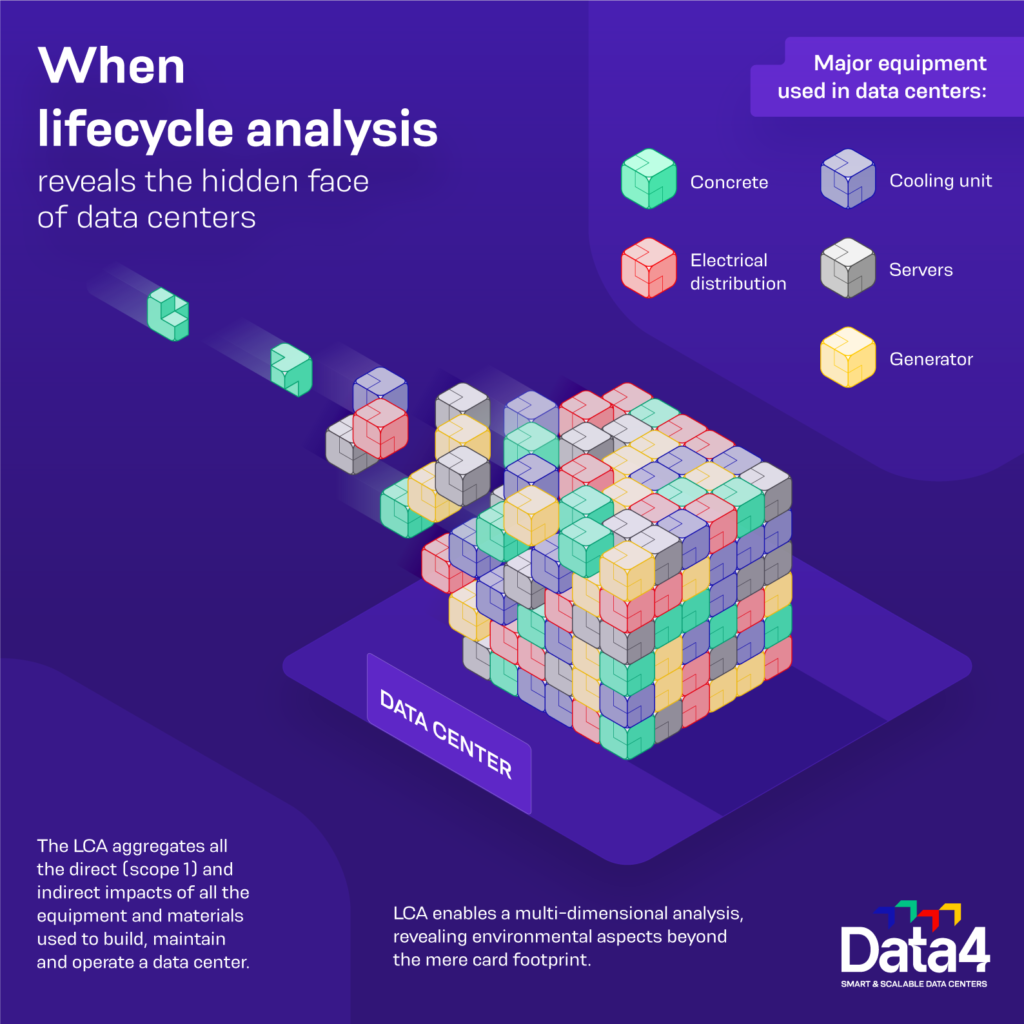
Analyzing the entire lifecycle of a data center is essential if we are to identify how the industry can keep its environmental impact to a minimum.
Linda Lescuyer, Innovation leader at Data4 Group
Today, it’s clear that minimizing greenhouse gas (GHG) emissions has become an essential consideration for data center operators seeking to expand their activities and facilities.
Apart from ensuring that their own operations have as little impact on emissions as possible, they need to assure their many cloud providers and other digital customers that they will continue to grow sustainably despite rising demands.
With data centers estimated to already account for 1 to 2% of global carbon emissions and their capacities being increased to meet the exponential demand of generative artificial intelligence (AI), an even more laser focus on the issue will clearly be required.
Yet raw data on carbon emissions forms just one part of the environmental equation. Hidden within that data are multiple other related issues. For example, climate change exacerbates the loss of biodiversity and the scarcity of water. As a planet we have become more aware of air, water and soil pollution, ocean acidification, the draining of natural resources like water and minerals, and the depletion of the ozone layer.
It is therefore crucial that the data center market goes far beyond just looking at surface emissions data to get to the root of addressing these manifold environmental impacts. That’s why lifecycle analysis (LCA) has become a highly useful tool for getting to the heart of the matter, adding in the influence of up to eight environmental impact measures – including those cited above – in assessing both the full impact of data centers and the separate technologies they contain.
Health check-up
One might consider LCA like visiting the doctor to cure a health issue whose cause is unknown at the outset. The doctor will examine all the possible reasons for the medical condition, then make a diagnosis and propose a cure.
In much the same way, LCA is about looking at all the issues behind an end symptom – for example, global warming contribution or raw material depletion. Its goal is to assess the impact of a technology “from cradle-to-grave” or a data center from the extraction of raw material, through construction to decommissioning of the building, resulting in a final report with a detailed analysis, figures and data that enable informed decisions about data center builds and technology upgrades.
Although the concept is still relatively new in the data center industry, we at Data4 have already been harnessing LCA systematically since 2020 and now have a large number of such analyses at our disposal. This enables us to draw up a European environmental profile for data centers, providing highly useful information to pinpoint how best to act for sustainability.
Such profiles can be instrumental in helping customers in their journey to net zero by helping cut their Scope 3 carbon emissions. These relate to emissions from assets not owned or controlled by an organization that indirectly affect its value chain, which are estimated to be more than ten times the size of a company’s direct emissions and therefore crucial to bring under control.
Key metrics
Among the headline figures in our analyses, we found that European data centers produced the equivalent of 6,600 to 10,400 tons of CO2 per megawatt of operational IT in facilities over a 20-year period, which is equivalent to the annual electricity consumption of 1,700 to 2,800 European households. This includes all the equipment and materials necessary to run a data center’s infrastructure, but excludes the manufacturing of IT equipment, as recommended by the emerging European standard “Product Category Rule for environmental assessment of datacenter IT hosting services and cloud services”. Some 80% of these emissions stem from energy used in operations. Meanwhile, construction alone is responsible for 1,500 to 2,100 tons of CO2 per megawatt of IT build.
These figures flag up some key areas in which a focus on improvements can boost the environmental outlook for data centers. With energy use accounting for such a large proportion of emissions, energy efficiency is one of the main priorities. With this in mind, we have calculated that by improving power usage effectiveness (PUE), carbon emissions can be reduced by 15%.
By continuing to address the sizable carbon footprint of buildings, we have identified that focusing on the building shell, which is commonly made from concrete and steel, is important. We measured that use of these materials together accounts for a quarter of the emissions from construction.
There are three main solutions for a better outcome on this front: one is using low-carbon concrete, which enables a 40% cut in carbon emissions and which Data4 has used for the foundations of all new data centers since 2022; another is using pre-existing structures and buildings; and a third is reducing the amount of space needed by increasing density and scaling down equipment size in IT and technical rooms.
A further area that needs attention and alternative approaches is the depletion of crucial mineral resources like aluminum, antimony, copper, and lead through use in electrical equipment and batteries. These together account for a substantial 60% of the reduction in natural resources linked to a data center. To limit the depletion of natural resources, it is important to favor reused or recycled materials. Implementing circular economy practices helps limit this impact.
Meanwhile, transportation of materials and equipment is responsible for about a quarter of the impact of building a data center – with one way to reduce this being the use of local suppliers.
A comprehensive view
These examples give just a snapshot of all the considerations necessary these days when it comes to implementing and maximizing the benefits of LCAs. We believe it is essential to have a holistic view to stay one step ahead as new data centers are rolled out.
As part of this, it’s crucial to involve the whole value chain of suppliers, enabling us to collect more precise information on the impacts of equipment and materials that are part of the construction of a data center and encourage them to find eco-designed solutions. We are now asking systematically about the product environmental profile or environmental product declaration in our procurement process.
And apart from our efforts in terms of equipment, construction and technologies, we have been striking power purchase agreements (PPAs) such as our recent partnerships with France’s Eurowatt and Photosol. Consisting of long-term contracts, these show a more robust commitment to forward-thinking energy initiatives.
Nobody is claiming that taking such a broad approach is easy – but it is necessary. And the more these solutions become the norm and are incorporated in the thinking of industry players, the more the market will be able to contribute actively to sustainability.
For Data4’s part, our various measures have already resulted in a 13% reduction in the carbon footprint of each MW build over the past six years and we’re targeting 38% by 2030. This is one of the main objectives of our innovation road map: finding and implementing technologies that reduce all the environmental impacts, throughout the entire life cycle of the data center.
Long-term viability
Ultimately, the use of LCA will hugely improve the sustainable future of our partners as well as ourselves.
LCA is also very useful for understanding the interdependencies and risks affecting our business. For example, it highlights our energy suppliers’ water requirements and other suppliers’ need for rare metals. By understanding these aspects, we can then seek innovative alternatives to adapt to future resource shortages.
Finaly, aside from being essential for our planet, this is crucial in falling in line with countries’ emissions and environmental targets over the coming years.
As emphasized, it’s not enough for the data center industry just to focus directly on carbon emissions and not dig into all the related underlying causes and impacts. Given our position as key contributors to society with significant footprints, we need to be putting ourselves at the center of the planet’s entire environmental journey.
That’s the only way we will guarantee a sustainable future and a lasting positive legacy for data centers – and that’s why we think LCA is the way forward to benefit both ourselves and the customers we support.


